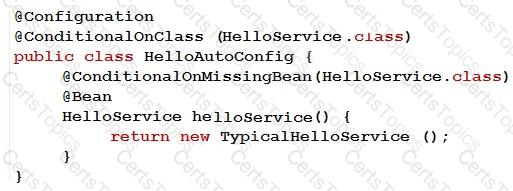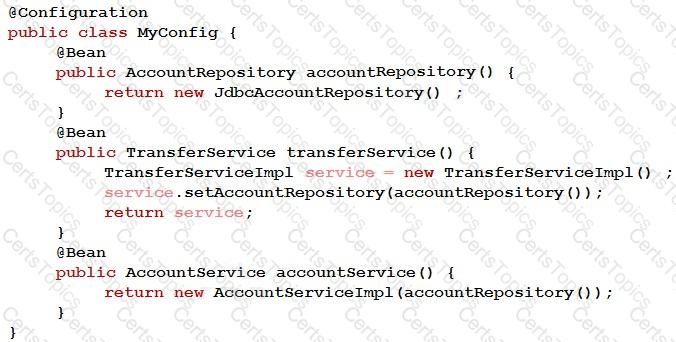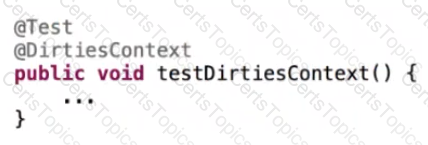Refer to the exhibit.

The above code shows a conditional @Bean method for the creation of a JdbcTemplate bean. Which two statements correctly describe the code behavior? (Choose two.)
Which two statements are true concerning constructor injection? (Choose two.)
Which two options are REST principles? (Choose two.)
Refer to the exhibit.

Which two statements are correct regarding the HelloAutoConfig auto-configuration class when it is specified in the META-INF/spring.factories file? (Choose two.)
Which three statements are advantages of using Spring’s Dependency Injection? (Choose three.)
Refer to the exhibit.

Which statement is true? (Choose the best answer.)
Which two statements are correct regarding the differences between @ConfigurationProperties and @Value? (Choose two.)
Which two annotations indicate that the transaction for a transactional test method should be committed after the test method has completed? (Choose two.)
Which two mechanisms of autowiring a dependency when multiple beans match the dependency's type are correct? (Choose two.)
Which two statements are true regarding Spring and Spring Boot Testing? (Choose two.)
Which three types can be used as @Controller method arguments? (Choose three.)
According to REST principles, which is the recommended way to update the order resource identified by 1234?
Which two statements are true about REST? (Choose two.)
Refer to the exhibit.

Based on the default Spring behavior, choose the correct answer. (Choose the best answer.)
Which statement describes the propagation behavior of Propagation.REQUIRES_NEW annotation? (Choose the best answer.)
Which two statements are correct regarding Spring Boot auto-configuration customization? (Choose two.)
Refer to the exhibit.

What statement is true about @DirtiesContext?
Which two statements are true regarding storing user details in Spring Security? (Choose two.)
Refer to the exhibit.

Which option is a valid way to retrieve the account id? (Choose the best answer.)
Which two options will inject the value of the daily.limit system property? (Choose two.)
Which two annotations are meta-annotations on the @SpringBootApplication composed annotation? (Choose two.)
Which two statements are true regarding @DataJpaTest? (Choose two.)